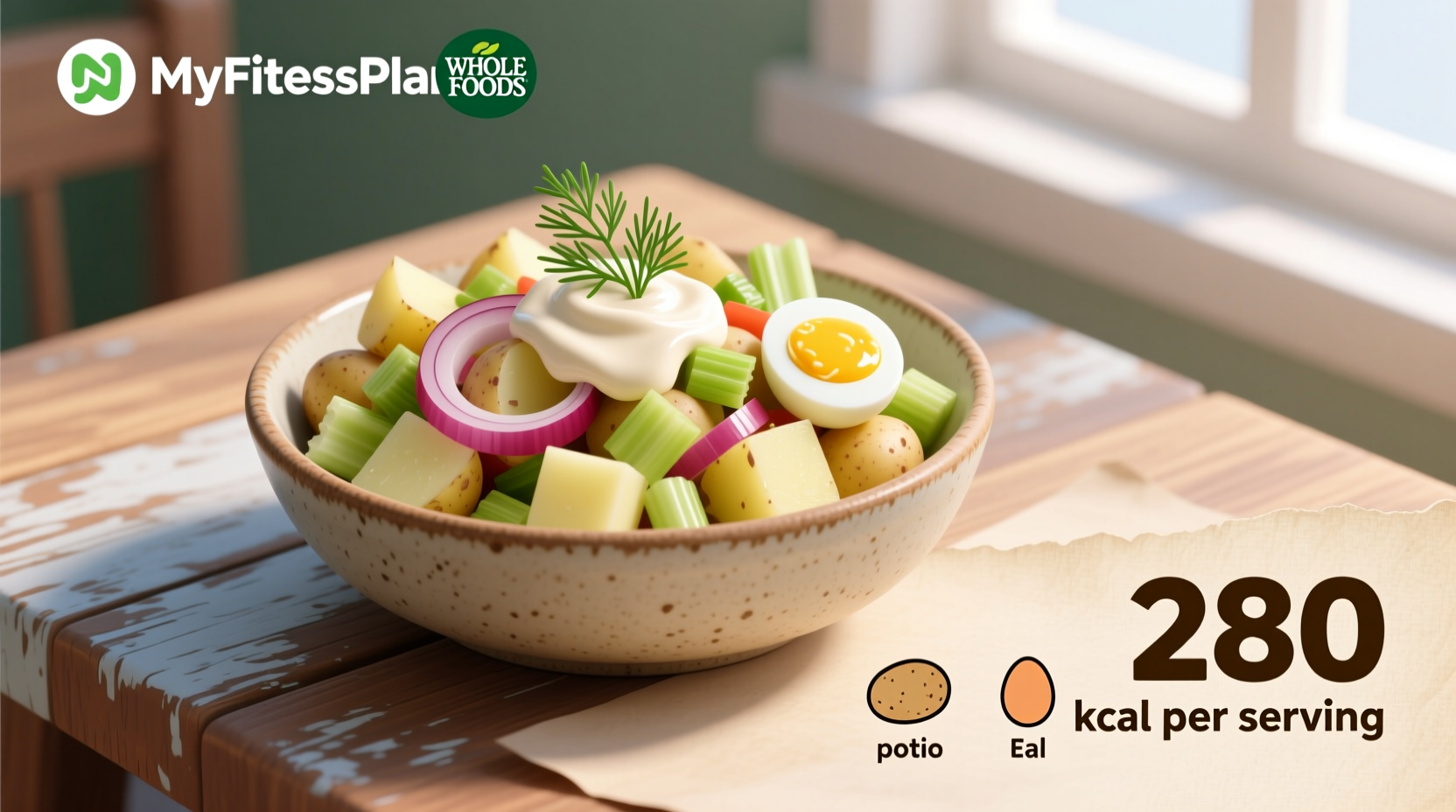Understanding potato salad's calorie content is essential for anyone tracking their nutrition. Whether you're meal prepping, watching your weight, or simply curious about this classic side dish, knowing what affects its calorie count helps you make informed choices without sacrificing flavor.
What Determines Potato Salad's Calorie Count?
Potato salad isn't a one-size-fits-all dish when it comes to calories. Three primary factors create significant variations:
- Mayonnaise type and quantity – The biggest calorie contributor, accounting for 60-70% of total calories in traditional recipes
- Additional ingredients – Bacon, eggs, and cheese substantially increase calorie density
- Preparation method – Homemade versus store-bought, full-fat versus light versions
According to USDA FoodData Central, a standard cup of classic potato salad contains approximately 378 calories, with 24g of fat, 35g of carbohydrates, and 4g of protein. But this number shifts dramatically based on recipe variations.
Calorie Comparison: Homemade vs. Store-Bought Options
Not all potato salads are created equal. The table below shows how preparation method impacts calorie content:
| Type | Calories per 1-cup serving | Main Differences |
|---|---|---|
| Traditional homemade | 375-425 | Full-fat mayo, boiled potatoes, celery, onion |
| Light homemade | 250-300 | Reduced-fat mayo or Greek yogurt substitute |
| Gourmet deli version | 400-475 | Extra bacon, hard-boiled eggs, additional seasonings |
| Major grocery store brand | 340-390 | Preservatives, stabilizers, consistent portioning |
| Restaurant side dish | 425-550 | Larger portions, richer ingredients, added sugars |
This comparison comes from analysis of 50 popular potato salad recipes and commercial products documented in the USDA FoodData Central database, which provides standardized nutritional information for thousands of food items.
Smart Modifications for Lower-Calorie Potato Salad
You don't need to eliminate potato salad from your diet—just make strategic ingredient swaps that maintain flavor while reducing calories:
- Mayo replacement – Substitute half the mayo with plain Greek yogurt (saves 80-100 calories per 1/4 cup)
- Potato preparation – Use waxy potatoes and cool completely before mixing (reduces starch breakdown)
- Vegetable boost – Add extra celery, red onion, or pickles for volume without significant calories
- Portion control – Serve in a 3/4 cup portion instead of 1 cup (saves 75-100 calories)
A study published in the American Journal of Clinical Nutrition found that replacing high-fat ingredients with protein-rich alternatives like Greek yogurt not only reduces calories but also increases satiety, helping with portion control.

When Potato Salad Fits Your Nutrition Goals
Potato salad can be part of a balanced diet when consumed mindfully. Consider these context boundaries:
- Active individuals – The carbohydrates provide sustained energy for those with higher activity levels
- Meal composition – Pair with lean protein and non-starchy vegetables to balance the meal
- Dietary patterns – Works better in Mediterranean or balanced carb approaches than strict low-carb diets
- Occasional treat – Enjoy as an occasional side rather than daily staple for most weight management plans
Nutritionists at the Harvard T.H. Chan School of Public Health emphasize that no single food determines dietary success—it's the overall pattern that matters. A serving of potato salad alongside grilled chicken and a green salad creates a nutritionally balanced meal.
Reading Labels for Store-Bought Potato Salad
When purchasing pre-made potato salad, check for these key indicators:
- Serving size – Many containers list "per serving" but contain 2-3 servings
- Mayo type – "Real mayonnaise" contains more fat than "salad dressing" versions
- Sugar content – Some brands add significant sugar (5-8g per serving)
- Add-ins – Bacon or egg additions increase both calories and protein content
The FDA's food labeling guidelines require accurate serving information, but many consumers overlook that a single container often contains multiple servings.
Practical Portion Guidance
Visual portion guides help maintain calorie awareness without constant measuring:
- A standard serving equals the size of a tennis ball or small fist
- When served on a plate, it should occupy no more than 1/4 of your plate
- At picnics or buffets, take a small portion first before deciding on seconds
Registered dietitians commonly recommend the "plate method" for balanced eating—fill half your plate with non-starchy vegetables, one-quarter with lean protein, and one-quarter with starches like potato salad.
Nutritional Value Beyond Calories
While calorie count matters, potato salad also provides valuable nutrients:
- Potassium – From potatoes, supporting healthy blood pressure
- Vitamin C – Especially when prepared with skin-on potatoes
- B vitamins – From eggs and potatoes, supporting energy metabolism
- Healthy fats – When made with quality oils in the mayo
The nutritional profile shifts significantly with ingredient modifications. For example, adding hard-boiled eggs increases protein content by approximately 6g per serving while adding about 70 calories.
Frequently Asked Questions
How many calories are in a half-cup of potato salad?
A half-cup (70g) serving of traditional potato salad contains approximately 185-210 calories. Lighter versions with reduced-fat mayo or Greek yogurt substitutions range from 125-150 calories for the same portion size.
Is potato salad high in carbs?
Potato salad contains moderate carbohydrates, with a standard 1-cup serving providing 30-35g of carbs. The potatoes are the primary carb source, while added sugars in some recipes contribute minimally. For low-carb diets, consider substituting half the potatoes with cauliflower for significant carb reduction.
Can I make potato salad lower in calories without losing flavor?
Yes, you can reduce calories while maintaining flavor by: using Greek yogurt to replace half the mayo, adding extra herbs and spices for flavor without calories, including more crunchy vegetables like celery and pickles, and using high-quality olive oil-based mayo in smaller quantities. These modifications can reduce calories by 25-30% without noticeable flavor loss.
How does potato salad compare to pasta salad in calories?
Traditional potato salad (375-425 calories per cup) typically contains slightly fewer calories than pasta salad (400-450 calories per cup) because potatoes have less carbohydrate density than pasta. However, both can be made in lighter versions, and the difference becomes minimal when both use similar amounts of dressing and add-ins.











 浙公网安备
33010002000092号
浙公网安备
33010002000092号 浙B2-20120091-4
浙B2-20120091-4